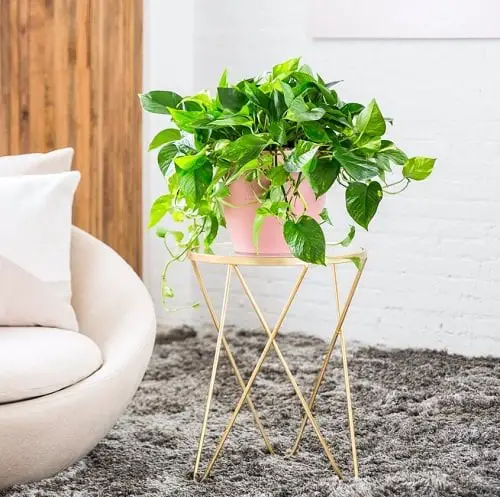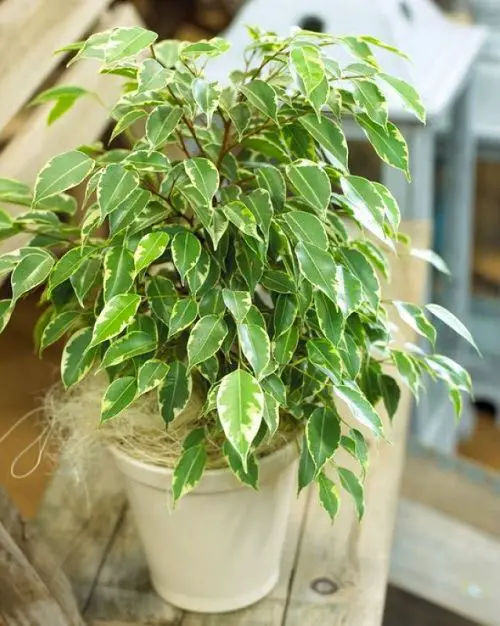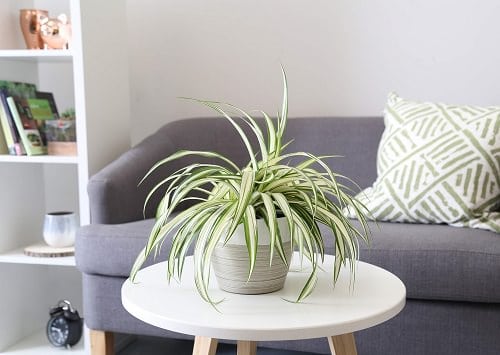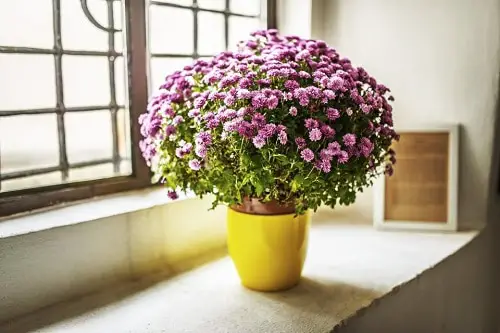These Oxygen producing houseplants are best according to science, and growing them indoors can boost your mental strength, immunity, and energy levels.
Plants with a large surface area can produce more oxygen with more openings called stomata to allow photosynthesis. As a result, they can be a great addition to the enclosed offices and homes, filtering out harmful pollutants and adding the essential element “O.”
Check out our article on NASA recommended houseplants here
List of Most Oxygen Producing Houseplants
1. Pothos

Botanical Name: Epipremnum aureum
Pothos is the number one indoor plant for oxygen due to its fast conversion rate. In an experiment, it was able to show a 6.5% reduction in carbon dioxide, where it decreased the CO2 content from 454PPM to 425PPM, thereby increasing the oxygen levels.
Also, the study by the Faculty of Engineering Technologies, Malaysia, states that pothos absorbed 17.10 percent of CO2, getting it down to 377 ppm from 455 ppm from the air in an enclosed chamber. You can learn more about it here.
Here’s everything you need to know about growing pothos indoors.
2. Peace lily

Botanical Name: Spathiphyllum wallisii
This study, done by the University of Technology Sydney, Australia, shows that peace lily can lower down the presence of carbon dioxide and help in boosting up the percentage of oxygen in a well-ventilated room by as much as 25%.
The plant also earned a place in NASA’s clean air study due to its air-purifying abilities.
Check out our article on growing peace lily here
3. Areca Palm

Botanical Name: Dypsis lutescens
Areca palm is prized with the ability to produce oxygen and increase its level in the area where it is kept. It also filters harmful pollutants like xylene, toluene, and formaldehyde.
Keeping two large houseplants like areca palm in 100 square feet area can enhance oxygen levels in the surrounding.
Here are some of the best palm varieties you can grow indoors
4. Snake Plant

Botanical Name: Sansevieria trifasciata
Also known as the mother-in-law’s tongue, a study done at Naresuan University, Phitsanulok, Thailand, validates it as one of the most oxygen-producing indoor plants as it could absorb carbon dioxide at 0.49 ppm/m3 in the closed system.
As it’s a CAM plant, it also emits oxygen and absorbs carbon dioxide at night, along with benzene, formaldehyde, xylene, and toluene. To learn more about snake plant benefits, click here.
Check out our article on growing snake plants at home here
5. Weeping Fig

Botanical Name: Ficus Benjamina
According to research by the Pukyong National University, Busan, Korea–The weeping fig was successful in lowering the concentration of CO2 from the air, thereby bumping up the oxygen levels by a considerable margin.
It is also a potent plant to filter out harmful VOCs like formaldehyde, benzene, and
trichloroethylene. If you want to know the name of more ficus plants to grow indoors, click here.
6. Orchid

Botanical Name: Orchidaceae
According to an article published on South Dakota State University extension, orchid releases oxygen at night, making it one of the best plants for bedrooms.
The lovely flowers of the plant will also make the space more aesthetic. Check out our article on growing orchids indoors here.
7. Spider Plant

Botanical Name: Chlorophytum comosum
Though the spider plant is not the most oxygen-producing plant on the list, it earned its place here as it is one of the best plants to reduce stress and increase productivity, according to the University of Vermont.
Some studies in the United States and the UK also state that this plant can lower down anxiety by 37%, depression by 58%, and fatigue by 38%. It also offers other benefits that you can read here.
Here’s all the information you need on growing spider plants indoors
8. Christmas Cactus

Botanical Name: Schlumbergera bridgesii
It actively uses carbon dioxide to create oxygen and glucose during photosynthesis, increasing the percent oxygen in the air. The plant also emits oxygen at night, according to the article published by the University of Connecticut.
As the plant looks quite stunning with its colorful flowers, this flowering succulent can be a beautiful addition to your home!
9. Dumb Cane

Botanical Name: Dieffenbachia
According to the study done at the Kastamonu University, Dumb Cane was effective in reducing the CO2 levels from 1,868 to 1,506 ppm within 24 hours, therefore, increasing the oxygen levels.
The plant also cleans off VOCs like acetone, benzene, formaldehyde, and toluene inside the home. You can read about its other benefits here.
Here are the different types of dumb canes you can grow
10. Chrysanthemum

Botanical Name: Chrysanthemum
Though it is not exactly known for its oxygen-producing capabilities, it is a great plant to clean the harmful VOCs off the air. The research done by NASA indicates that it was able to remove 76,931 total micrograms of Benzene from the air in 24 hours.
As mums have more leaves, oxygen production is significantly higher than the other houseplants.



I did not know you could grow a Chrysanthemum year round in a house or condo. Is that true?
You can if you have south or west facing windows–maybe some extra with light especially made for plants if you don’t.
Research a bit on the computer. I have ferns, etc. in my north windows, and sun lovers in the south windows.
I had a wandering jew plant that someone grew beautifully for me and I put it out on my balcony, 3 rd floor. I don’t think it could withstand the high winds and rain when we get afternoon showers or storms. I have some cuttings left over from the bottom of it and will start a new one. Thoughts?
Sadly many of these plants are toxic to kitties ☹️
Cannabis plants make very good house plants. Non toxic to pets.
I agree with you
Up up up, good